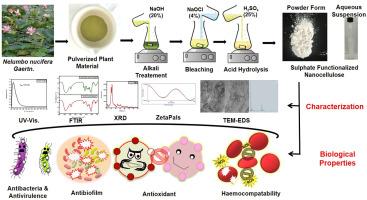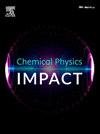莲子硫酸盐功能化纳米纤维素的杀菌和抗毒潜力
IF 4.3
Q2 CHEMISTRY, PHYSICAL
引用次数: 0
摘要
世界卫生组织(WHO)发出严厉警告,称世界正在“耗尽抗生素”,这加剧了人们对抗生素耐药性威胁不断升级的担忧。抗生素耐药(AR)细菌的日益流行严重破坏了目前治疗传染病的有效性。糖尿病足感染是导致非创伤性下肢截肢的主要原因之一,其病原菌如金黄色葡萄球菌和铜绿假单胞菌在严重感染中起主导作用,通常伴有粪肠球菌和大肠杆菌。为了应对这一紧迫的医疗挑战,本研究评估了从莲叶中合成的硫酸盐功能化纳米纤维素(S-NC)的抗菌和抗毒性能。S-NC主要通过破坏生物膜的形成,对关键的dfi相关病原体表现出强大的抗菌活性。此外,它还能有效抑制群体感应调节的毒力因子,降低铜绿假单胞菌中pyocyanin(68.58%)和pyoverdine(70.33%)的产量,以及金黄色葡萄球菌中葡萄黄质(67.90%)的产量。结构表征证实了良好的物理化学性质:x射线衍射(XRD)显示出高结晶度(74.83%),场发射扫描电子显微镜(FE-SEM)显示出螺旋纤维形态,团聚最小,透射电子显微镜(TEM)显示长宽比为6.53,紫外可见光谱测定带隙能量为4.25 eV。此外,S-NC具有良好的血液相容性和显著的抗氧化潜力,自由基清除活性为82.45%。这些发现表明,莲蓬衍生的S-NC有望作为一种多功能治疗药物,在生物医学应用中对抗抗生素耐药性和改善感染结果。本文章由计算机程序翻译,如有差异,请以英文原文为准。

Bactericidal and antivirulence potential of sulphate-functionalized nanocellulose extracted from Nelumbo nucifera Gaertn
The World Health Organization (WHO) has issued a stark warning that the world is “running out of antibiotics,” amplifying concerns about the escalating threat of antibiotic resistance. The growing prevalence of antibiotic-resistant (AR) bacteria has severely undermined the effectiveness of current treatments for infectious diseases. This issue is particularly critical in managing diabetic foot infections (DFIs), a leading cause of non-traumatic lower limb amputations, with pathogens such as Staphylococcus aureus and Pseudomonas aeruginosa playing a dominant role in severe infections, often accompanied by Enterococcus faecalis and Escherichia coli. In response to this urgent healthcare challenge, the present study evaluates the antimicrobial and antivirulence properties of sulphate-functionalized nanocellulose (S-NC), synthesized from Nelumbo nucifera Gaertn.
The S-NC exhibited potent antibacterial activity against key DFI-associated pathogens, primarily through the disruption of biofilm formation. Moreover, it effectively inhibited quorum sensing-regulated virulence factors, reducing pyocyanin (68.58 %) and pyoverdine (70.33 %) production in P. aeruginosa, and staphyloxanthin (67.90 %) in S. aureus. Structural characterization confirmed favorable physicochemical properties: X-ray diffraction (XRD) revealed high crystallinity (74.83 %), field emission scanning electron microscopy (FE-SEM) showed a helical fibrous morphology with minimal agglomeration, transmission electron microscopy (TEM) indicated an aspect ratio of 6.53, and UV–Visible spectroscopy determined a band gap energy of 4.25 eV.
Furthermore, S-NC demonstrated excellent hemocompatibility and notable antioxidant potential, with a radical scavenging activity of 82.45 %. These findings suggest that Nelumbo nucifera-derived S-NC holds promise as a multifunctional therapeutic agent for combating antibiotic resistance and improving infection outcomes in biomedical applications.
求助全文
通过发布文献求助,成功后即可免费获取论文全文。
去求助
来源期刊

Chemical Physics Impact
Materials Science-Materials Science (miscellaneous)
CiteScore
2.60
自引率
0.00%
发文量
65
审稿时长
46 days
 求助内容:
求助内容: 应助结果提醒方式:
应助结果提醒方式:


